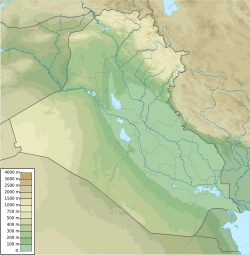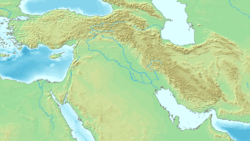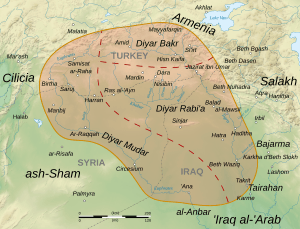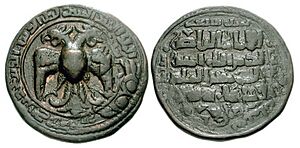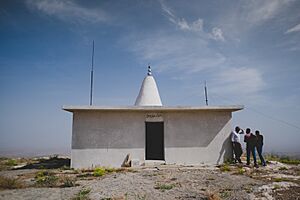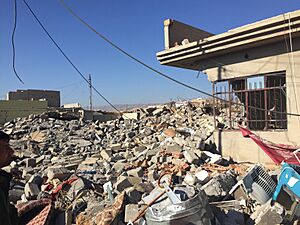Sinjar facts for kids
Quick facts for kids
Sinjar
شنگاڵ
Şingal
|
|
|---|---|
|
Town
|
|
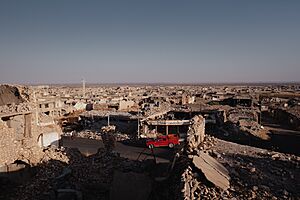
Sinjar in 2019
|
|
| Country | |
| Governorate | Nineveh |
| District | Sinjar District |
| Elevation | 522 m (1,713 ft) |
| Population | |
| • Total | 88,023 |
| Time zone | UTC+3 (GMT) |
Sinjar (Arabic: سنجار, romanized: Sinjār; Kurdish: شنگال, romanized: Şingal, Syriac: ܫܝܓܪ, romanized: Shingar) is a town in northern Iraq. It is part of the Nineveh Governorate and is located about five kilometers south of the Sinjar Mountains. In 2013, about 88,023 people lived there. Most of the people in Sinjar are Yazidi.
Contents
Sinjar Through Time
Ancient History
Around the 2nd century AD, Sinjar was a military base for the Roman Empire. It was called Singara back then. The town was a battleground between the Roman and Sasanian empires. It changed hands many times. In the 6th century, people living in Singara included Pagans, Christians, and Jews. Not much of the ancient town can be seen today.
Islamic Era
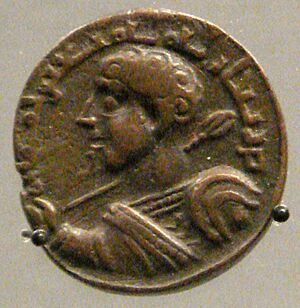
Arab Muslims took control of Sinjar in the 630s–640s. Later, different Arab and Turkmen groups ruled the city. From the early 1100s to the mid-1200s, Sinjar was very successful.
A ruler named Qutb ad-Din Muhammad built a new wall around the city. Sinjar had two walls for protection. During this time, the city also had two mosques, six schools for Islamic law (called madrasas), and places for religious gatherings. A tall tower (minaret) from this time still stands.
Later, the Mongols attacked Sinjar in 1262. They destroyed the city's double wall and a shrine. However, the shrine was rebuilt. Many famous Islamic scholars came from Sinjar. One writer called Sinjar "little Damascus" because of its beautiful bathhouses. Another traveler, Ibn Battuta, visited Sinjar. He said the people there were brave and kind Kurds. He also noted that the main mosque was surrounded by a stream.
The Ottoman Empire took control of Sinjar in 1534. It became an important district center. In the 17th century, a traveler named Evliya Çelebi wrote about Sinjar. He said the city had Kurds and Arabs. The nearby Sinjar Mountains were home to many Yazidi and Baburi Kurds.
Modern Sinjar
In the 1970s, the Iraqi government moved many people out of Sinjar. They replaced them with Arabs. This was part of a "modernization drive." Many of these Arab families still live in the area today.
In 2013, Sinjar had about 77,926 people. The city was home to Kurds, Arabs, Turkmens, and Assyrians. People practiced different religions, including Yazidism, Sunni Islam, and Christianity. Sinjar had schools, a hospital, parks, and sports fields. It also had three churches, but these were later destroyed.
Conflict in 2014
In August 2014, a group called the Islamic State of Iraq and the Levant (ISIL) took over Sinjar. This led to many Yazidi people leaving their homes. ISIL committed terrible acts against the Yazidi people.
Kurdish forces tried to take back Sinjar in December 2014. They faced strong resistance from ISIL. Finally, in November 2015, Kurdish forces and Yazidi fighters, with help from US airstrikes, took back the city. After Sinjar was freed, a mass grave was found nearby. It contained the remains of many Yazidi women.
Current Situation
In 2017, the Yazidis in Sinjar announced they wanted their own local government. Later that year, Iraqi forces took control of the town. Control was given to a Yazidi group.
In 2020, there were concerns about people returning to their homes in Sinjar. In 2021, the Iraqi government asked local Yazidi protection forces to leave Sinjar. The Yazidi administration did not agree. This has led to calls for peace in the region.
Notable People
- Ahmad Sanjar, a powerful Sultan of the Seljuk Empire.
See also
 In Spanish: Sinyar para niños
In Spanish: Sinyar para niños


